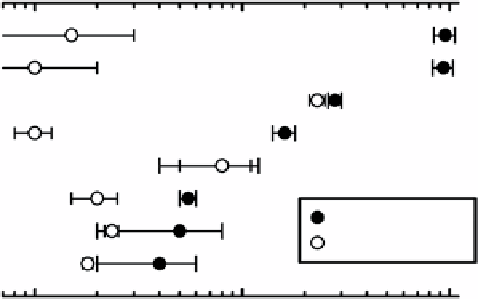Geology Reference
In-Depth Information
The meteorite contains agglutinates and abundant glass
spherules. Lithic clasts are predominantly VLT basalt or
gabbro, but feldspathic clasts are also present. Pyroxene
grains in the basalt are coarse grained and finely exsolved,
suggesting a hypabyssal setting [summary from
Jolliff
et al
., 1998;
Arai and Warren
, 1999; and
Korotev et al
.,
2003b].
There is no evidence to suspect that QUE 94281 is
paired with QUE 93069/94269 (Figures 6.3, 6.7, and
6.11). There is, however, strong compositional, mineral-
ogical, textural, and CRE evidence that QUE 94281 is
launch paired with paired stones Yamato 793274 and
Yamato 981031 [
Dreibus et al
., 1996;
Jolliff et al
., 1998;
Kring et al
., 1996;
Polnau and Eugster
, 1998].
Arai and
Warren
[1999] make the strongest argument by showing
that the same two distinctive types of mare volcanic
glass dominate the glass populations in each of the two
meteorites. QUE 94281 and Yamato 79/98 are similar in
composition (Figure 6.12). There is also strong evidence
that the “YQ” meteorites [
Arai and Warren
, 1999] are
launch paired with EET 87/96. Both compositionally
and texturally, the coarse-grained basalt or gabbro
component of the YQ meteorites is similar to that of
EET 87/96 [
Kring et al
., 1996;
Korotev et al
., 2003b]
(Figure 6.12). Crystallization ages of the basalt lithol-
ogies are the same, within uncertainty (Figure 6.8).
Finally, NWA 4884 from the Sahara Desert is identical
in composition to QUE 94281 for lithophile elements
[
Korotev et al
., 2009b] (Figure 6.12). The preliminary
petrographic description of NWA 4884 is consistent
with that of QUE 94281 [
A. Irving and S. Kuehner
, in
Connolly et al
., 2007].
On any of a number of two-element plots, the “YQEN”
meteorites (Yamato 79/98, QUE 94281, EET 87/96, and
NWA 4884) plot along a mixing line between VLT basalt
and a nonmare component that is richer in incompatible
elements, Na
2
O, and TiO
2
and is more magnesian than
most feldspathic lunar meteorites (Figures 6.12 and 6.13)
[
Korotev et al
., 2003b]. On the basis of compositional
mass balance,
Jolliff et al
. [1998] estimated 46% nonmare
material in QUE 94281, whereas
Arai and Warren
[1999]
estimated ~33%; the difference reflects different assump-
tions about the compositions of the mare and nonmare
components.
EET 87/96 is richer in the mare component than the
other YQEN meteorites. As with the YAMM meteorites
(next section), the YQEN meteorites appear to originate
from a place where feldspathic ejecta overlies a deposit
of mare basalt. EET 87/96 represents deeper, immature,
basaltic regolith, whereas QUE 94281, Yamato 793274/
981031, and NWA 4884 represent a shallower, more
mature regolith consisting of basaltic material, felds-
pathic material, and perhaps some KREEP-bearing
material.
PCA
MET
MAC
Q93/94
E87/96
LAP
Ejection age
Terrestrial age
Q94
ALH
710
20
30
50
100
200 300
500
1000
Age (ka)
Figure 6.11.
Ejection ages and terrestrial ages for ANSMET
lunar meteorites ALH A81005, QUE 94281, LAP 02205 and
pairs, EET 87521/96008, QUE 93069/94269, MAC 88015, MET
01210, and PCA 02207 [after
Nishiizumi et al
., 1996;
Nishiizumi
,
2003]. Data are from
Jull
[2006],
Nishiizumi
[2003],
Nishiizumi
and Caffee
[1996],
Nishiizumi et al
. [1991, 1996, 1999, 2006], and
Thalmann et al
. [1996].
The meteorite is rich in impact-glass spherules and
fragments. Most glasses have feldspathic compositions,
but a small fraction have mafic composition, some
corresponding to medium-Ti mare basalt. Glass concen-
trations have a wide range of
Mg'
(55-96) and some have
high-aluminum, silica-poor [
Naney et al
., 1976] composi-
tions. Agglutinate clasts are present and grains of FeNi
metal are abundant [
Bischoff
, 1996;
Grier et al
., 1995;
Koeberl et al
., 1996,
Korotev et al
., 1996;
Robinson and
Treiman
, 2010;
Spettel et al
., 1995;
Warren and Kallemeyn
,
1995;
Warren et al
., 2005].
The most unusual aspect of the meteorite is that the
regolith of which it is composed is more mature than that
of most meteoritic regolith breccias. As a consequence of
the high surface exposure, concentrations of solar wind-
implanted noble gases [
Thalmann et al
., 1996], siderophile
elements (Figure 6.9) [
Korotev et al
., 2006], and impact-
glass spherules and fragments are all at the high end of
the ranges observed among lunar meteorites. The mete-
orite also has a strikingly vesicular fusion crust from
release of the solar wind-implanted gases from the sur-
face melt during atmospheric entry (Figure 6.5).
6.5.5. Queen Alexandra Range 94281
QUE 94281 is a clast-rich regolith breccia consisting
of both basaltic and feldspathic material. “The matrix
is very heterogeneous. In most areas, it is a fine-grained,
glass-poor fragmental material, but several large
regions—up to 5 mm across—have extremely fine-grained
(glassy aphanitic) dark-brown matrix along with relatively
low fragment/matrix ratio” [
Arai and Warren
, 1999].

